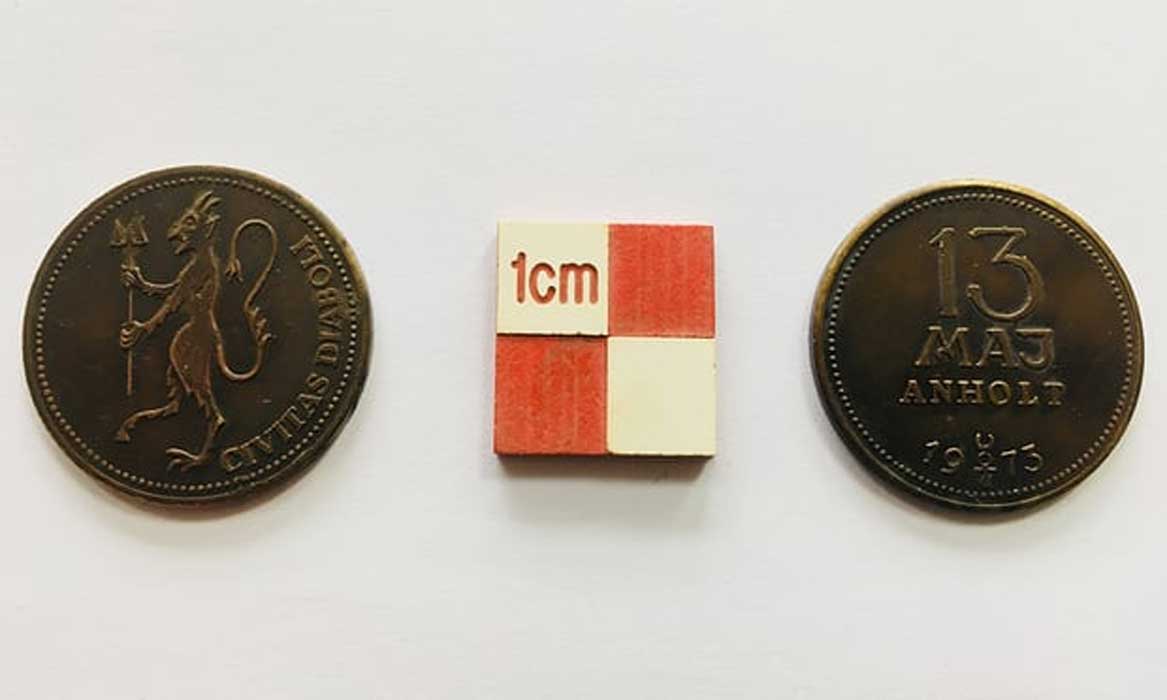Satanic Panic Hit As ‘Devil Coins’ Were Unearthed Beneath Bath Abbey
Hidden beneath 19th century stalls in Bath Abbey, Somerset, England, ‘bewildered’ restoration archaeologists discovered a pair of coins depicting a horned and hoofed, trident-wielding devil and the words “Civitas Diaboli” (city of the devil). But don’t have a Satanic panic just yet!
According to a report posted on Wessex Archaeology's website, their team “knew immediately they were not on the trail of some hitherto unknown Medieval devil worshippers.” The reverse side of the coins were inscribed “13 Maj Anholt 1973” and further research revealed that this pair of stirring Satanic tokens were crafted by an “unassuming art gallery clerk from Denmark, who orchestrated an elaborate international practical joke in 1973,” a joke which Scandinavians often call “the prank of the century.”

Detail of a ‘devil coin.’ (Wessex Archaeology)
It all began in May 1973, “around the full moon,” on the remote Danish island of Anholt when islanders began finding evidence of Satanic rituals; “Polynesian-looking masks, bones wrapped in string, and a fake human head on a stake that was planted in the sand through a child’s sandal strap” according to Jesper Aagaard Petersen, a renowned Norwegian academic.
- Supreme Court Judge: Of Course I Believe in the Devil! ...Do You?
- Stan Patitul and his Infernal Pact with the Devil
These discoveries didn’t really move the islanders to much, but overzealous journalists created outright panic when they claimed to have uncovered evidence of human sacrifice, that was, until the alleged victim called the police to advise them that she was “unsacrificed and living on the Danish mainland” according to a report in The Independent.

Anholt island, the backdrop for a series of unusual pranks. (Old Dane/CC BY SA 4.0)
The “Devil Coins” started appearing in church crypts, behind statues and “even behind paintings at the police headquarters in Copenhagen.” In total, standing testimony to the scale of this hoax, in a later paper Jesper Aagaard Petersen recorded that almost “400 Devil Coins were recovered around Denmark,” and abroad in “tourist destinations around Scandinavia.”
To further enhance this apparent wave of Satanism, the evil genius behind this plan, the so called ‘Satanic high priestess Alice Mandragora’ (on other occasions ‘Karl Klunck’ or ‘Dunk Wokgnal’) sent out a series of bizarre letters, for example, The Independent reported that the director of Rosenborg Castle, keeper of the Danish crown jewels, received “an outsize human tooth in the post” with instructions to, “find a place for the Divine Tooth in the display with the crown jewels,” before a change of heart led him to demand, “Actually, it should be entirely on its own on a tray of pure gold.”

‘Satanic high priestess Alice Mandragora.’ (Køge Museum)
For four decades the Satanic prankster thrived, until 2013 when the Danish broadsheet newspaper Politiken revealed that the whole wave of Satanism had “all been a massive practical joke perpetrated by Knud Langkow… a telephone clerk at the National Gallery of Denmark.” And, the answer to the perpetrators identity was obvious all time - his alter ego “Dunk Wokgnal” - was “Knud Langkow’s name backwards!
Langkow died in 2004 aged 73, and when Politiken’s reporters told them the truth, his former colleagues at the gallery “were stunned.” “It’s perfectly crazy that it’s him,” said Chris Fischer, a former gallery worker who remembered Langkow. “He was completely ordinary, quite conventional and grey,” Fischer told journalists at the Independent.
What Inspired this Gentle Danish Devil to Strike?
“Despite his obvious intelligence,” his niece Lene Langkow Saaek told Politiken, “Knud’s education had been cut short by financial hardship that forced him to find work to help his family make ends meet… had he found more fulfilling work, his niece speculated, he might not have devoted so much time and effort to his extraordinary prank.” So far as Knud’s inspiration is concerned, she pointed a finger towards an uncle, who she recalled, “had been an atheist with an elevated, intelligent sense of humor.”
- Danila Prepeleac – The Man Who Tricked the Devil
- The Devil Walks Among Us: The Myth of The Jersey Devil

Knud Langkow. (Private photo/Politiken)
This story really splits me. On one hand, a man who personally funded the minting of 400 Devil Coins, then spent decades hiding them in churches and sacred buildings, might have been in desperate need of medical help? But justifying his actions, his niece said; “I think normality annoyed him, he did not like ordinary.” She added: “He wanted to leave his mark on the world.”
And to that end, Knud totally and absolutely succeeded. I think that he was deeply depressed, and like so many other great artists, in their darkest times they produce their most emotive, abstract, and eccentric art. The ‘Devil Coins’ are rightfully exhibited by the highly respected National Museum of Denmark and curators have referred to Langkow’s hidden Satanic Coins, and devilish letters as “a Gesamtkunstwerk” – a universal work of art.
With that sentiment, I agree 100%.
Top Image: The ‘devil coins’ were found when stalls were removed for restoration work in the abbey. Source: Wessex Archaeology
By Ashley Cowie



















